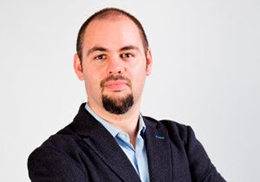
Unai Ansejo, external professor for the Master’s Degree in Banking and Quantitative Finance since 2007 (University of the Basque Country), has founded together with two colleagues the first entirely automated investment service in the country, after approval from the National Stock Markets Agency (CNMV).
The Fintech movement overcomes another hurdle in Spain. Thanks to professor Ansejo, François Derbaix and Ramón Blanco, this project, Indexa Capital, has seen the light, aspiring to compete with traditional banking in the current times of high volatility and low gain. According to the company’s own estimations, their commissions and fees are «80% lower than what banks and investment funds are currently offering in Spain».
Professor Ansejo is the CEO, co-founder and chairman of the Board of Directors of Indexa. He has been a part of the Interuniversity Official Master’s Degree in Banking and Quantitative Finance since April 2007 as the lecturer for our subject in «Risk Management», besides acting as both a director and evaluator/commentator of our student’s second year research projects (having participated in our Workshops). He was also one of the first alumnus in the then-called Interuniversity Doctoral Programme in Quantitative Finance. He is currently the fixed-income portfolio manager of the Itzarri EPSV pension fund. An extended CV can be read here.
The way Indexa operates is, in theory, pretty straightforward. Investors – whose initial contribution must be equal to or superior than 10.000€ – are asked to answer a 10-question survey that will determine the risk burden they are able or willing to withstand with their investment. The result, quantified on a scale from 1 to 10, is what will assign one portfolio or another to the client. Depending on the result, his portfolio will be more volatile (higher number shares) or stable (public bonds), following this table:
Calculations used to define each type of portfolio are based on – in their own words – the Modern Portfolio Theory described by Harry M. Markowitz in 1952 and for which he won the Nobel Prize in Economics in 1990.
The distribution of every portfolio is outlined by management and approved by the Advisory Board. The automated nature of Indexa actually refers more to the daily handling of each individual portfolio. The system is programmed to be aware of any variable attributes that could indicate changes in a client’s profile, or any deviation in the weighting of his portfolio (each asset category can differ up to 3% from the prefixed goals): ageing, overvaluing of an asset, a change in a client’s financial situation (renewal of the questionnaire is required every three months). According to Indexa, the system is not designed necessarily to maximise capital gains, but to minimise risks for every client (that’s why every investment is fragmented into hundreds of assets and potentially over a hundred countries).
In the U.S.A., this kind of business, better known as robo-advisors, has multiplied in the last five years. The main competitors, Wealthfront and Betterment, move up to three billion dollars worth of assets each.
Resources used:
Press release by Indexa Capital
Report by Cinco Días – Management companies, a ‘click’ away from their clientele
Report by El Español – Automated investors “conquer” Spanish markets








